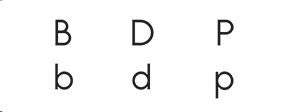Do you have students who confuse one letter with another letter? For example, a student might incorrectly read big for the word pig or dig. A student can easily confuse the lowercase letters b, d, p, and q, to name a few. This is because each of these letters has an overall form that is identical or very similar to another letter’s form when rotated, flipped, or reversed.
We know students must be able to identify a letter correctly in order to associate the letter with its sound. So, a student who confuses letters with similar forms is not able to quickly and accurately decode words. Some students also rotate, flip, or reverse letters in their writing. By setting up a simple strategy, you can help your students take responsibility for accurately identifying and writing visually similar letters. Consistent use of the strategy will help students master these letters and avoid letter reversals, rotations, and inversions.
In English, the relationship between the shapes and the names of letters is largely arbitrary, so students must memorize the links between letter shapes and names (Treiman and Kessler, 2003). Most early reading programs teach the uppercase letters first, because uppercase letters are more distinguishable than lowercase letters.
Identical Upper- and Lowercase Letters are letter pairs whose forms are almost identical. Students typically learn these letter pairs quickly.
| Identical Upper- and Lowercase Letters |
.png) |
Visually Confusing Letters are lowercase letters whose overall form is identical or similar to another lowercase letter’s form. In a study, researchers found that similarity of these lowercase letter shapes caused the most confusion errors (Treiman, Kessler, and Pollo, 2006). More time is needed to teach these lowercase letters.
| Visually Confusing Letters |
.png) |
An effective way to offer support and hold a student accountable for accuracy is to provide a cue card that displays pairs of uppercase and lowercase letters. The example below shows a cue card for confirming b, d, and p—lowercase letters that are frequently confused.

Provide a student with a cue card like the one pictured above. Direct the student to refer to the cue card whenever he or she reads or writes a word with one of these lowercase letters. The student should confirm a lowercase letter on the bottom of the cue card by double-checking it with its more distinguishable uppercase form on the top. By confirming the identity of the lowercase letter with its uppercase counterpart over and over again, the student moves toward mastery.
Providing an incentive may motivate a student to check very carefully each time. For example, if a student doesn’t confuse any of the letters on the cue card on a written assignment, the teacher may award bonus points, send the paper home with a positive note, post it on a special bulletin board for outstanding work, etc.
Free cue card templates (including sample cue cards for the letters b, d, and p) are available on the Read Naturally website. You can use these templates to create custom cue cards and then print them on sheets of self-stick labels or on card stock that can be cut apart. You can also create individualized cue cards with Post-it® Notes for the specific letters that student tends to confuse.
Cue cards are an effective strategy to support beginning and developing readers by holding them accountable for knowing their letters. Try this strategy with beginning or developing readers working in Read Naturally’s GATE, Word Warm-ups, and Signs for Sounds.

 Share your student’s success story—nominate him or her for our Star of the Month award. Win a Barnes & Noble gift card for the student and a Read Naturally gift certificate for your class!
Share your student’s success story—nominate him or her for our Star of the Month award. Win a Barnes & Noble gift card for the student and a Read Naturally gift certificate for your class!
Thank you very much for the download of the cue card.